Swine Nutrition Requirements and Feed Formulation Standards
Balanced nutrition is key to pigs' growth, reproduction, and feed efficiency. Nutrient needs differ greatly across stages and types. Based on PIC research and practical experience, this article outlines the core nutritional needs and diet design for each stage.

Core Principles of Feed Formulation
The core of feed formulation is to balance cost and nutrition. The aim is not only fast growth but also better feed efficiency.
A practical formula focuses on net energy (NE) and amino acid levels to control cost and improve performance. Energy makes up about half of total feed cost, and the NE system gives a clearer measure of ingredient value.
Formulas should use SID lysine as the base, adjust other amino acids, and include suitable minerals and vitamins for balanced nutrition.
Simply put: efficient feed = smart energy + balanced amino acids + cost control.
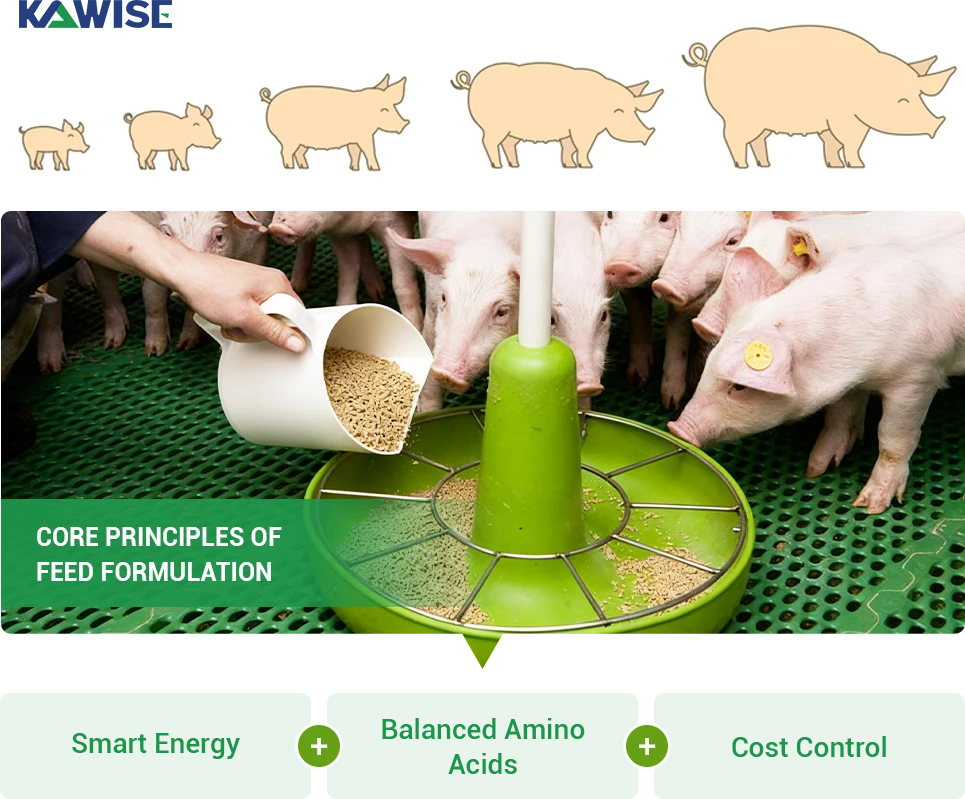
Key Nutritional Needs
A pig's nutrition depends not only on energy and protein but also on amino acids, minerals, vitamins, and water intake.
Because ingredient digestibility varies, formulas should be based on standardized ileal digestible (SID) amino acids, using lysine as the reference to balance others-this is vital for muscle growth and feed efficiency.
Minerals and vitamins also play key roles:
- Keep the calcium-to-phosphorus ratio between 1:1 and 1.5:1, and use STTD phosphorus to assess absorption.
- Sodium helps maintain fluid balance; deficiency can reduce feed intake.
- Zinc, copper, iron, manganese, and selenium support immunity and hoof health; organic forms absorb better.
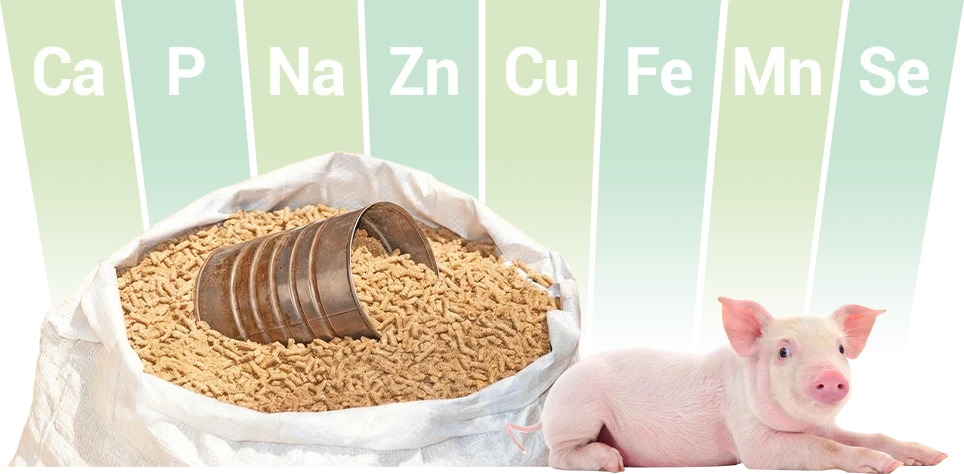
Adding functional additives improves nutrient use:
- Phytase boosts phosphorus availability.
- Zinc or copper supports growth and reduces diarrhea.
- Xylanase enhances fiber digestion.
Finally, ensure proper feeding systems, enough feeder space, and clean water supply to maintain steady intake and healthy growth.
Commercial Pig Production
This stage includes nursery and grower–finisher pigs. The goal is to support steady growth, keep the digestive system healthy, and improve feed efficiency.

Nursery pigs
Stage: From weaning to around 20–23 kg.
Feed at this stage makes up about 10–15% of total feed cost and is usually divided into early (3.5–7.5 kg) and late (7.5–23 kg) phases. This helps match nutrition to gut development and improves survival.
In the early phase, piglets have limited digestion. Feed should include digestible protein sources such as whey powder and fish meal to maintain intake and reduce diarrhea.
In the later phase, as gut function improves, milk ingredients can be reduced and soybean meal and grains increased to transition toward a standard grower diet.
Recommended Nutrient Levels for Nursery Pigs
| Item | Unit | 3.5–7.5 kg | 7.5–23 kg |
| Metabolizable Energy (ME) | kca/kg | 13.8–13.9 | 14.1–14.3 |
| Crude Protein (CP) | % | 21.0 | 19.5 |
| SID Lysine | % | 1.46 | 1.32 |
| Calcium (Ca) | % | 0.80 | 0.71 |
| Total Phosphorus (P) | % | 0.65 | 0.60 |
| Copper (Cu) | mg/kg | 150 | 150 |
| Zinc (Zn) | mg/kg | 100 | 100 |
| Vitamin E | IU/kg | 50 | 50 |
Feed Processing and Particle Size
Feed particle size has a direct impact on nutrient absorption and feed intake.
Recommended sizes:
- Mash feed: 500–600 μm
- Pellet feed: below 500 μm (ideally around 400 μm)
A finer grind increases pellet density and overall feed quality.
Using well-made pellets can raise feed intake and feed conversion by around 8%.
When pelleting, keep the temperature below 77 °C to avoid protein damage in plasma or dairy ingredients, and make sure fines do not exceed 20% of total feed.

Finishing Pigs (Barrows and Gilts)
The goal at this stage is to build lean meat efficiently and maximize profit. Feed costs take up nearly half of total expenses, so diets should focus on cost-effectiveness, not just lower cost.
Finishing pigs depend on energy balance. Keep a proper ratio of energy to lysine, and gradually reduce protein and amino acids as weight increases to avoid excess fat. (High-energy feed can improve daily gain by 3–4% and feed conversion by about 10%.)
Gilts need slightly more lysine to support muscle growth, while barrows are more prone to fat gain if amino acids are insufficient.
Typical Nutrient Reference (Barrows)
| Body Weight (kg) | Daily Gain (kg/d) | Feed Intake (kg/d) | Lysine-to-Energy Ratio (g/Mcal) |
| 23–40 | 0.83 | 1.43 | 4.71 |
| 40–60 | 0.90 | 2.06 | 4.04 |
| 60–80 | 1.02 | 2.64 | 3.48 |
| 80–105 | 0.98 | 2.67 | 3.05 |
| 105–Market | 0.91 | 2.77 | 2.82 |
Note:Gilts need slightly more lysine to support lean growth.
Feed Processing and Management
Feed ingredients should balance cost and meat quality.
High-fiber diets can reduce carcass yield, so switch to a low-fiber formula (NDF < 9%) about 15–20 days before market.
To keep good fat texture, control the linoleic acid level in added oils and limit DDGS to under 20% of the diet.
- Keep grain particle size below 500 μm.
- Each pig needs at least 10 liters of clean water per day.
- Lack of amino acids, sodium, or phosphorus can cause tail biting and other abnormal behaviors, so maintain a balanced diet.
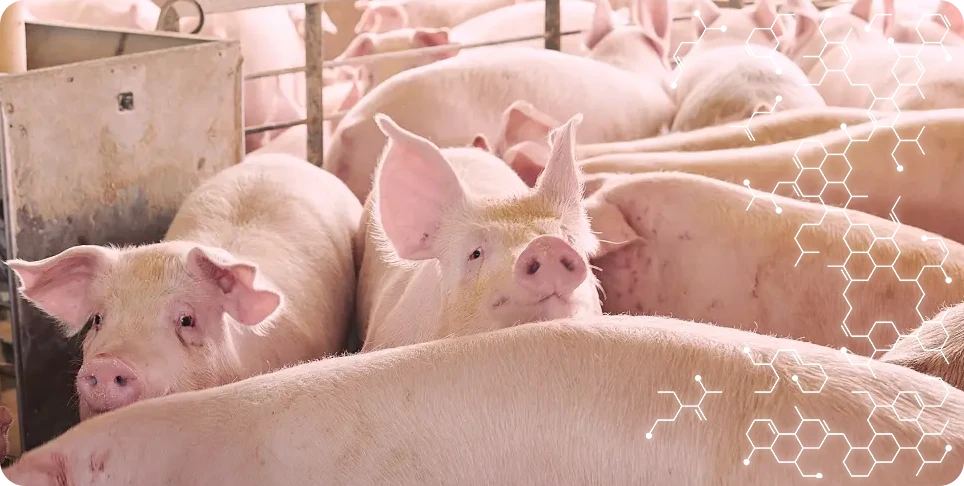
Breeding Pigs
Breeding pigs include sows and boars. The main goal is to keep healthy body condition for good fertility and longer productivity.
Feed should stay balanced in energy, protein, and minerals so sows maintain normal heat, pregnancy, and milk production.
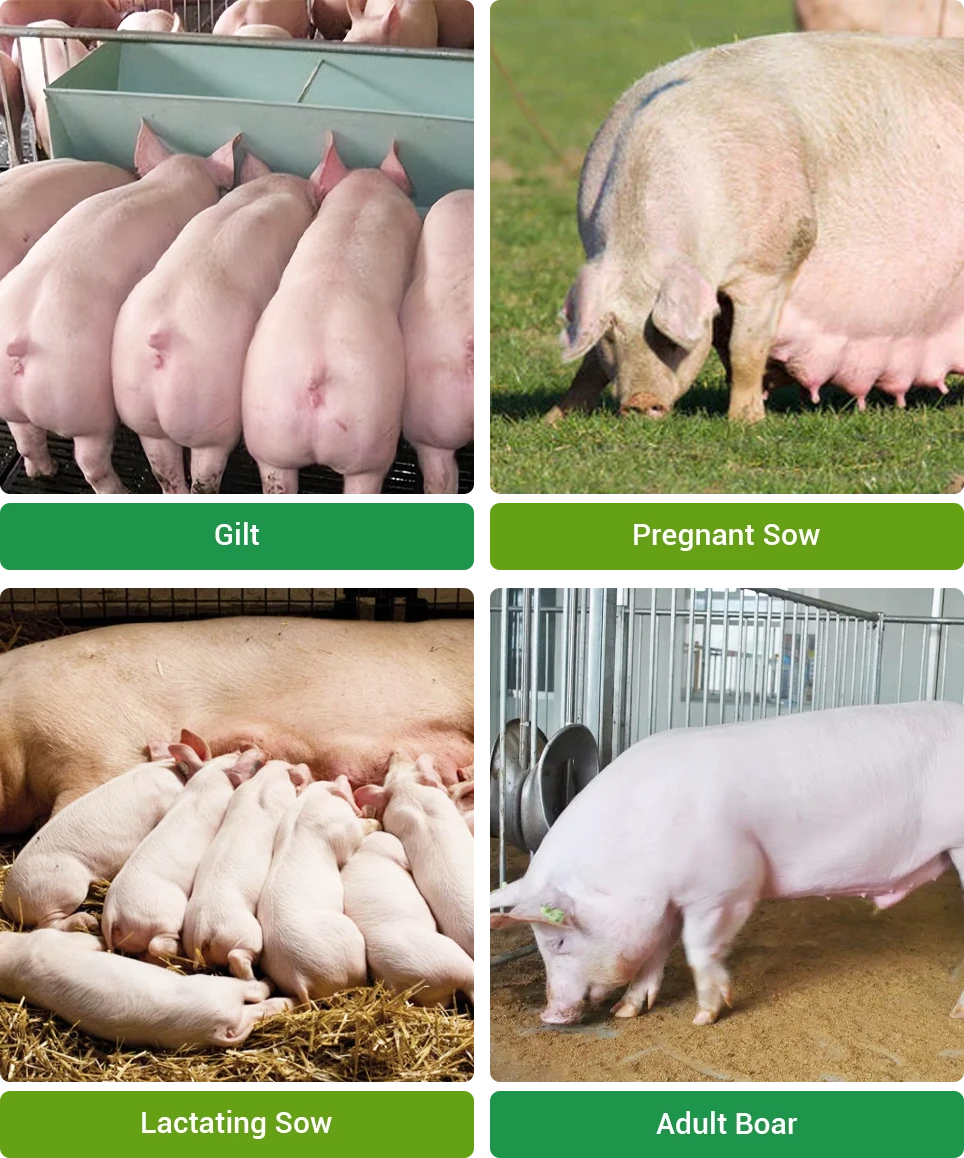
Adult Boars
The goal of feeding adult boars is to maintain good body condition, improve semen quality, and reduce leg and hoof problems. Proper nutrition and management are essential for stable fertility.
Feed amount depends on body condition:
- Normal boar: about 2.5 kg per day
- Lean boar: about 2.7 kg per day
- Fat boar: about 2.3 kg per day
Nutrient Reference for Adult Boars
| Item | Unit | Recommended Level |
| Metabolizable Energy (ME) | kcal/kg | 3100 |
| Net Energy (NE) | kcal/kg | 2300 |
| Crude Protein (CP) | % | 14.0 |
| SID Lysine | % | 0.60–0.65 |
| Calcium (Ca) | % | 0.8 |
| Digestible Phosphorus (STTD P) | % | 0.22 |
| Salt (NaCl) | % | 0.4 |
| Zinc (Zn) | mg/kg | 120–130 |
| Iron (Fe) | mg/kg | 100 |
| Manganese (Mn) | mg/kg | 50 |
| Selenium (Se, organic) | mg/kg | 0.3 |
| Vitamin A | IU/kg | 11 000 |
| Vitamin D3 | IU/kg | 2 000 |
| Vitamin E | IU/kg | 100–120 |
| Daily Water Intake | L/day | ≥ 17 |
Feed Processing and Management
For boar diets, the recommended grain particle size is 750–900 μm to reduce the risk of stomach ulcers caused by overly fine grinding.
If possible, set up two grain storage bins, with one dedicated to feed for boars, gilts, and pregnant sows to ensure proper particle size and feed quality.
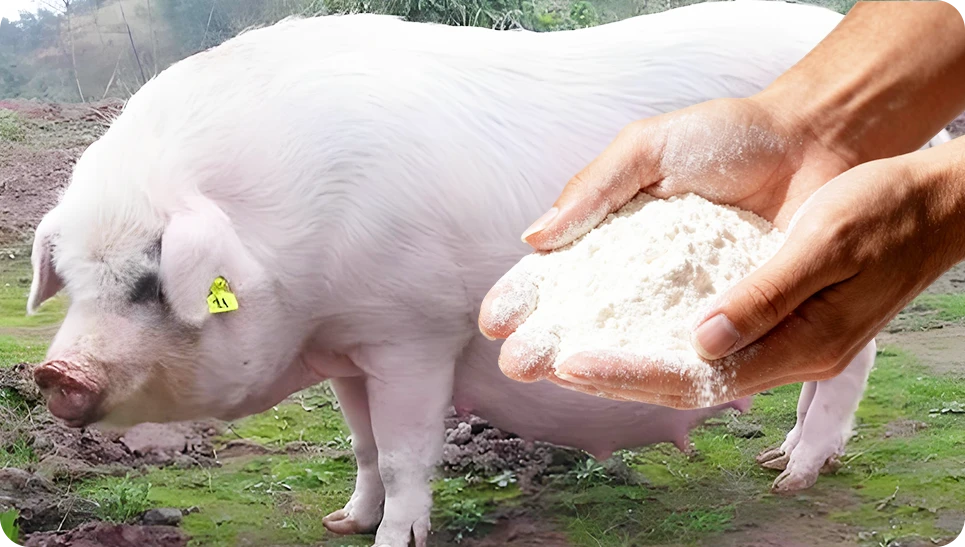
Pregnant Gilts and Sows
Keeping sows in good body condition is key to stable reproduction. Ideally, the spine, hip, and ribs should not be clearly visible but can be felt by touch. If the bones cannot be felt when pressed, the sow is likely overweight.
The goal is to keep about 90% of sows within this ideal condition range.
Overweight sows at farrowing often eat less, lose more weight, and produce less milk. This can lead to lighter piglets at weaning and weaker fertility later.
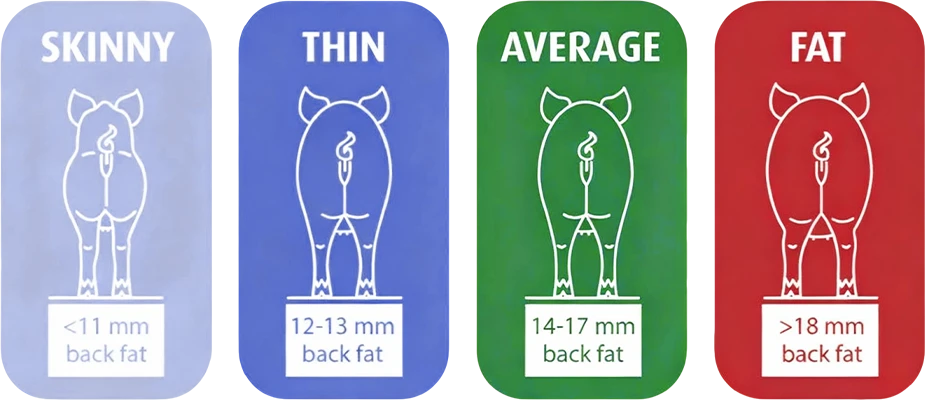
Pregnant sows in good condition are usually fed in three stages. Feed amount and nutrients are adjusted as the fetus grows and the sow's condition changes.
| Days | Gilts (kg/day) | Sows (kg/day) | Goal |
| 0–28 | 2.3 | 2.3 | Rebuild body reserves |
| 29–90 | 1.8 | 1.8 | Maintain condition and placenta growth |
| 90–114 | 2.7 | 1.8 | Support fetal growth and prepare for birth |
For sows outside the ideal condition, adjust feed accordingly:
Thin sows: slightly increase feed for a short period to restore body reserves.
Fat sows: reduce feed gradually to reach ideal condition and prevent excess energy from affecting fertility.
For sows that are too thin or too fat, adjust feeding based on their condition.
- Increase feed slightly for thin sows to help restore body reserves.
- Limit feed for fat sows to bring them back to normal condition and avoid reduced fertility from excess energy.
Nutrient Reference for Pregnant Sows (Ideal Condition)
| Item | Unit | Recommended Level |
| Metabolizable Energy (ME) | kcal/kg | 3230 |
| SID Lysine | % | 0.60 |
| SID Lysine / NE (gilts) | g/Mcal | 2.18 |
| SID Lysine / NE (sows) | g/Mcal | 2.09 |
| Threonine / Lysine (SID) | ratio | 76 |
| Tryptophan / Lysine (SID) | ratio | 19 |
| Valine / Lysine (SID) | ratio | 71 |
| Calcium (Ca) | % | 0.85 |
| STTD Phosphorus (P) | % | 0.24 |
| Vitamin A | IU/kg | 9920 |
| Selenium (Se) | ppm | 0.3 |
| Minimum Water Intake | L/day | 19 |
Feed Processing and Management
Grain particle size should be kept between 750–900 μm to improve digestion and reduce the risk of stomach ulcers.
For ingredient mixing:
- Wheat bran ≤10%
- DDGS ≤20%
- Rapeseed meal (low-glucosinolate type) ≤15%
If triticale is used, check ergot alkaloid levels ≤200 ppb to avoid negative effects on reproduction.

Lactating Sows
Lactation is the most demanding stage. The goal is to maximize feed intake for milk production and to reduce weight loss.
Allow free feeding from farrowing to support body condition. Increasing intake from 3.2 to 9.1 kg/day improves milk yield and piglet growth.
During lactation, gilts eat about 5.2 kg/day, sows about 6.0 kg/day. Keep feed fresh, feeders clean, and provide at least 19 L of water daily.
Lactating Sow Nutrition Reference
| Item | Unit | Recommended Level |
| Feed Intake | kg/day | 5–6 |
| Net Energy (NE) | kcal/kg | 2489 |
| SID Lysine | % | 1.0 |
| Threonine / Lysine | ratio | 63 |
| Methionine + Cystine / Lysine | ratio | 56 |
| Calcium (Ca) | % | 0.85 |
| STTD Phosphorus (P) | % | 0.44 |
| Sodium (Na) | % | 0.24 |
| Zinc (Zn) | ppm | 125 |
| Iron (Fe) | ppm | 100 |
| Copper (Cu) | ppm | 15 |
| Vitamin A | IU/kg | 9920 |
| Vitamin D | IU/kg | 1985 |
| Vitamin E | IU/kg | 66 |
| Biotin | μg/kg | 220 |
Feed Processing and Management
Grain should be finely ground, with an average size of 500–600 μm, to improve nutrient absorption and ensure high milk yield.

Weaned Sows
Feeding after weaning aims to help sows restore body reserves lost during lactation and support ovulation for the next litter.
- Thin sows: allow free feeding to speed up recovery.
- Normal or fat sows: feed at least 3.6 kg per day.
Use mainly gestation feed, and if possible, feed 2–3 times daily for steady nutrition.
Provide at least 19 L of water per sow daily, with one drinker for every 1–2 sows to ensure water supply.
Keep feed fresh and minimize waste to encourage intake and recovery.
Weaned Sow Nutrition Reference
| Item | Unit | Recommended Level |
| Net Energy (NE) | kcal/kg | 2390 |
| Metabolizable Energy (ME) | kcal/kg | 3230 |
| Lysine (Lys) | % | 0.60 |
| Lysine / NE | g/Mcal | 2.13 |
| Methionine + Cystine / Lysine | ratio | 70 |
| Threonine / Lysine | ratio | 76 |
| Tryptophan / Lysine | ratio | 19 |
| Calcium (Ca) | % | 0.85 |
| STTD Phosphorus (P) | % | 0.24 |
| Vitamin A | IU/kg | 9920 |
| Vitamin E | IU/kg | 66 |
| Folic Acid | μg/kg | 1325 |
Feed Processing and Management
Weaned sows are usually fed gestation feed, so processing should follow the same standard. Grain should be ground to 750–900 μm to preserve nutrients and reduce the risk of stomach ulcers.
The actual nutrient intake should be calculated based on each sow's daily feed intake.
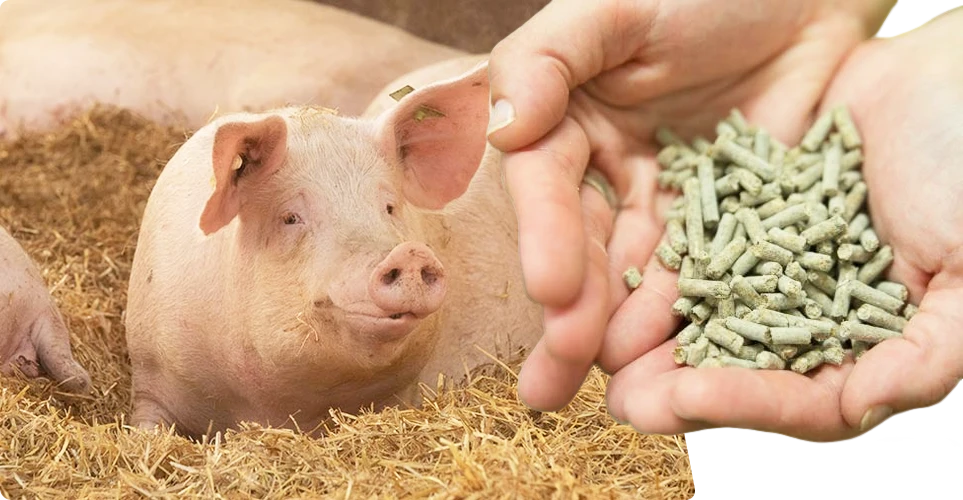
The values above serve as general guidelines for diet formulation and management, but adjustments should be made according to feed intake levels, ingredient quality, and local farm conditions.

Reference
1. PIC. Hendersonville, TN: Pig Improvement Company, 2016. Nutrient Specifications Manual (Metric Edition)
2. NRC. National Research Council, 2012. Nutrient Requirements of Swine (11th Revised Edition)
3. PIC Technical Update Series, Tables F1–N1, 2016. Sections on Feed Processing, Amino Acid Ratios, and Energy Systems
4. Graham, A. B., Williams, N. H., Tokach, S. A., et al. (2015). Effects of feed intake on reproductive performance in weaned sows. Midwest ASAS Meeting, Des Moines, Iowa. Available at ASAS Conference Abstract No. 11486
5. Patience, J. F. (2012). University of Minnesota Digital Conservancy. The metabolic basis of feed-energy efficiency in swine
6. Journal of Animal Science. Koketsu, Y., Dial, G. D., Pettigrew, J. E., & Marsh, W. E. (1996). Effects of lactation feed intake and creep feeding on sow and piglet performance
 Online Contact
Online Contact Send Message
Send Message
Need Some Help?
Contact us quickly and we will reply you within 24 hours. We will not disclose your information.